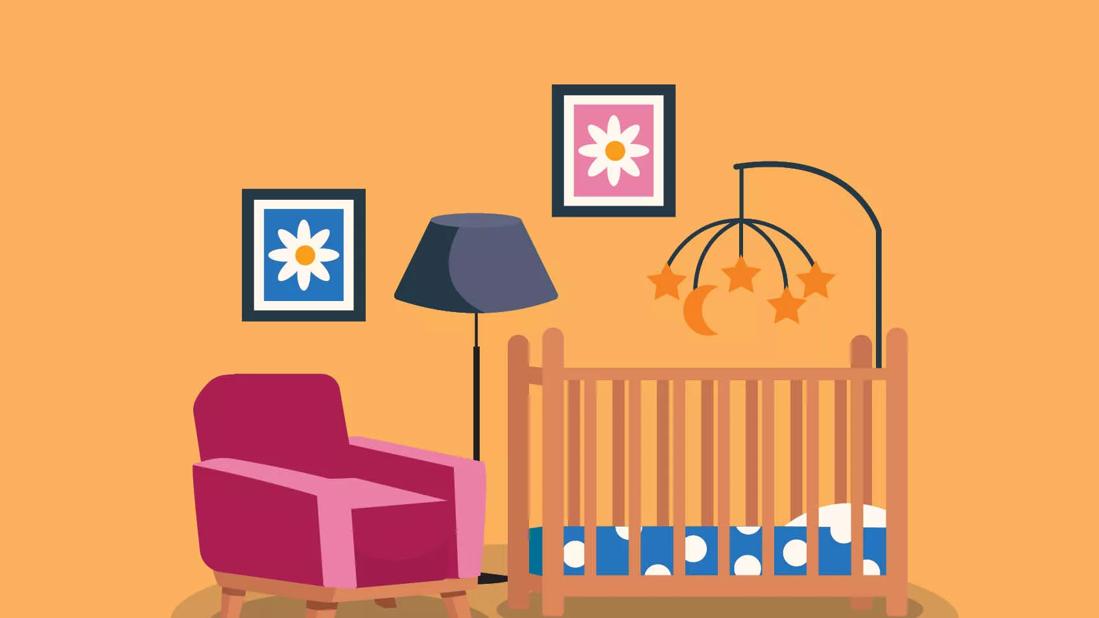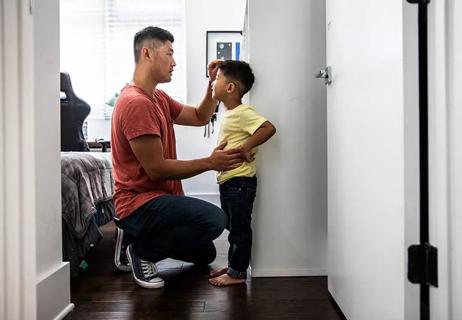There’s no magical age or height — it’s all a matter of your baby’s mobility

Funny how quickly things change when it comes to babies, right? One day it’s all swaddles and burp cloths and tummy time. Then, before you know it, they’re crawling around trying to drink out of the dog’s water bowl.
Advertisement
Cleveland Clinic is a non-profit academic medical center. Advertising on our site helps support our mission. We do not endorse non-Cleveland Clinic products or services. Policy
Babies hit new milestones faster than you can say, That’s one for the baby book. And while you’re looking for a pen, you might want to grab a screwdriver, too. Because as your baby becomes more mobile, it’s a cue that it’s time to lower their crib.
“Lowering the crib isn’t so much about age, it’s about your baby’s abilities,” says pediatrician Laura O’Connor, MD. “The more mobile your baby gets, the lower the crib should go.”
So, if you can’t plan on your calendar when the right time is, how will you know when to lower the crib mattress? Dr. O’Connor shares some tips for what to look for.
Sure, back in the day, cribs with drop-down sides were all the rage. But they’ve been banned after they were found to result in serious injuries and even deaths.
Most cribs these days come with high, middle and low settings for the mattress. That’s for both parents’ comfort and baby’s safety.
Think about it: If your newborn’s crib mattress was down below your knees, you’d be reaching awfully low to place them in bed. And it would be just about impossible to get them back out without crawling in yourself. (Don’t do that. Your crib isn’t meant to hold an adult’s weight.)
On the other hand, a baby who can stand would be in danger of taking a big tumble if their mattress was only a few inches below the crib rail.
Advertisement
But all those different height settings can be confusing. You’ll rest easier knowing your little tot is safe in their crib. Dr. O’Connor helps us take the guesswork out of each crib setting with this quick reference guide:
| Developmental stage | Sleeping arrangement | Approximate age |
|---|---|---|
| Newborn. | Bassinet or crib’s highest setting. | Under 4 months. |
| Baby who can roll over. | Crib’s highest setting. | 4 months old. |
| Baby who can sit up, “commando crawl” or get up on their hands and knees. | Crib’s middle setting. | 6 months old. |
| Baby who can stand up or pull themselves up to standing. | Crib’s lowest setting. | 9 months old. |
| Baby who can climb out of the crib or has outgrown the crib. | Big-kid bed. | Anywhere from 18 months to about 3 years old. |
| Developmental stage | ||
| Newborn. | ||
| Sleeping arrangement | ||
| Bassinet or crib’s highest setting. | ||
| Approximate age | ||
| Under 4 months. | ||
| Baby who can roll over. | ||
| Sleeping arrangement | ||
| Crib’s highest setting. | ||
| Approximate age | ||
| 4 months old. | ||
| Baby who can sit up, “commando crawl” or get up on their hands and knees. | ||
| Sleeping arrangement | ||
| Crib’s middle setting. | ||
| Approximate age | ||
| 6 months old. | ||
| Baby who can stand up or pull themselves up to standing. | ||
| Sleeping arrangement | ||
| Crib’s lowest setting. | ||
| Approximate age | ||
| 9 months old. | ||
| Baby who can climb out of the crib or has outgrown the crib. | ||
| Sleeping arrangement | ||
| Big-kid bed. | ||
| Approximate age | ||
| Anywhere from 18 months to about 3 years old. |
Consult your crib’s instruction manual for specifics on how to lower the crib mattress. Most manufacturers provide them online if you can’t find yours. Be sure to tighten all screws securely.
If your infant has been sleeping in a bassinet, they should be moved to a crib by the time they can roll over, Dr. O’Connor says. For many babies, that happens somewhere around 4 months old.
But bassinets have different height and weight restrictions. Even if your little one isn’t yet rolling, if they’ve reached the maximum height or weight for the bassinet, it’s time to move to a crib to make sure they have the stability and protection they need.
The highest setting on your crib is the right place for babies who can’t sit up.
“Infants have so little control over their bodies, it’s important for their safety, and for everyone’s comfort, if parents don’t have to bend too far to lay them down or pick them up,” O’Connor explains.
After rolling over, other mobility milestones come fast. And with baby’s new moves comes another shift in crib height.
Dr. O’Connor says you should plan to move your crib mattress to the middle height before your baby can crawl. Move the crib down when your baby can start to do any of these pre-crawling actions:
Many babies begin to hit these milestones around 6 months old. But they may come even earlier, so let your baby’s abilities be your guide.
Standing and walking are probably two of the most exciting milestones in your baby’s first year. And they’re signs that it’s time for the crib to be lowered for its last time.
“By the time your baby can stand up or pull themselves up, their crib should be at its lowest setting,” Dr. O’Connor notes. “If the crib mattress is too high, it becomes a big fall risk.”
Some babies may start off standing by using furniture (or whatever’s handy … say, your leg) to pull themselves up. And the rails on their crib can be perfect for pulling up.
So, even if your baby doesn’t stand up independently yet, any standing is a sign that it’s time to move the crib mattress to its lowest point.
And don’t let sleep sacks or other swaddles lull you into a false sense of security. Sure, they can make standing harder. But even with a sleep sack on, your baby can try to pull themselves to standing. So, if they can get up on their own two feet without the sleep sack, it’s time to make the crib at low as it goes.
Advertisement
After the crib reaches its lowest point, it can stay there for a while, Dr. O’Connor says. Most toddlers should sleep in a crib until they’re at least 18 months old. Some may not need to move to a toddler bed until well after their third birthday.
The American Academy of Pediatrics recommends toddlers move to a bed if:
“If your baby is climbing out of their crib or has outgrown it and causing a dangerous situation, it’s time to move to a bed. If not, it’s better to save the bed for a while,” Dr. O’Connor advises. “Beds come with a lot of autonomy and responsibility for your child, so the longer you can wait, the better for most people.”
Of course, crib height is just one part of making sure your baby has a safe sleep environment. You also want to make sure you’re following these other safe sleep practices during your baby’s first year:
Advertisement
If you have any questions about crib safety or safe sleep, Dr. O’Connor says to talk with your child’s healthcare provider. They can help you understand the best ways to keep your baby safe and sleeping soundly.
Advertisement
Learn more about our editorial process.
Advertisement

This child development strategy is all about meeting your child where they are

Tiny taste-testing is a way babies can explore their world, relieve aching gums and self-soothe

Start with a few minutes a day and work your way up to an hour or more to help your baby hit developmental milestones

This important activity helps babies reach developmental milestones like rolling, sitting up and crawling

Being the oldest, youngest or middle child may affect characteristics and traits, but the theory isn’t an official medical or psychological diagnosis

Being the oldest female sibling in your family can have an impact on your personality and behavior

Your little one may be up and walking as early as 9 to 12 months

Factors like genetics and nutrition, and even disease and medication, can affect height

If you’re feeling short of breath, sleep can be tough — propping yourself up or sleeping on your side may help

If you fear the unknown or find yourself needing reassurance often, you may identify with this attachment style

If you’re looking to boost your gut health, it’s better to get fiber from whole foods